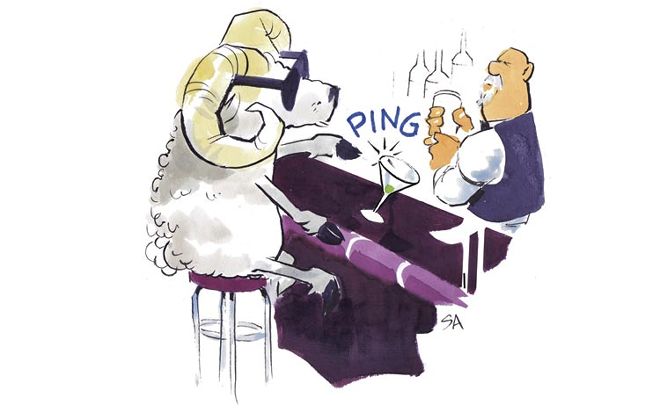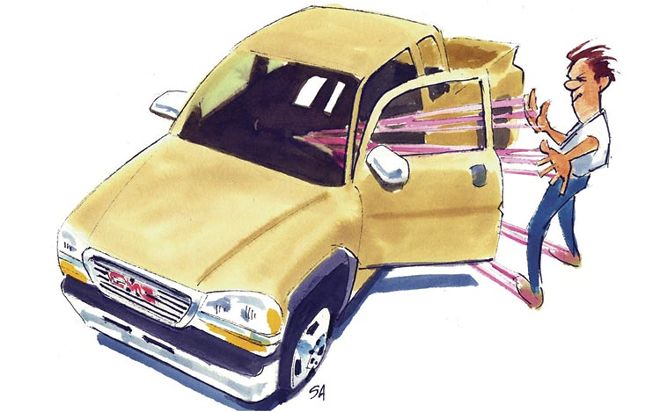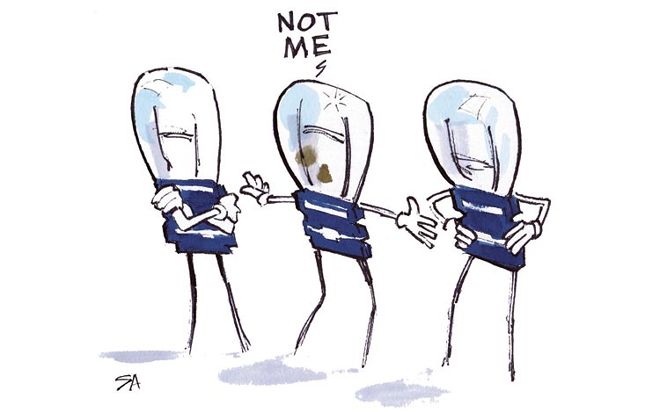
| advice WHY IS MY RAM PINGING
WHY IS MY RAM PINGING?Q: My 1998 Dodge Ram 1500 has the 5.2-liter V-8 engine. Starting at 18,000 miles, it started pinging. I've been through three brands of fuel and all the grades. The Dodge dealer that services my truck hasn't been able to figure out what's causing the problem or how to cure it. So far, the techs have replaced the intake plenum gasket and intake manifold gasket, flushed the fuel injectors, and serviced the throttle body. The truck now has 45,000 miles and is still pinging. Can you think of any cure for this chronic condition the Dodge dealer may not know about?
A: I have a couple of suggestions that aren't on the list of work that was performed, but the Dodge dealer certainly should know about them. First is an internal vacuum leak at the intake-manifold plenum gasket, a common failure that can cause a spark knock on several Dodge engines. Hopefully, the gasket was replaced correctly. Next time you visit the service department, ask them to pull up Technical Service Bulletin #18-48-98. This deals with another common cause of a misfire and/or spark knock on multiple engines, including the 5.2-liter, and involves rerouting the ignition wires as a fix. And last, but not least, TSB #18-05-00G recommends a software recalibration to eliminate the spark knock when all else fails. Be absolutely sure that all of the above have been completed before going any further. Keep in mind that high engine coolant temperatures can also induce a spark knock, and long-term knocking can cause internal engine damage. Improper combustion eats away at pistons.

| advice STICKY FUEL INJECTED GMC
STICKY, FUEL-INJECTED GMCQ: My 2000 GMC 2500 4x4 has a sticky accelerator. When the truck is off, the accelerator pedal depresses smoothly. After I start the truck, the accelerator pedal sticks upon initial depression, but is fine after that. I checked the cable at the throttle housing unit and it seems to be working fine. What could be the problem? Any suggestions would help.
A: That sticking feel you described is common with a variety of engines. It's actually the throttle plate itself sticking within the bore of the throttle-body assembly. Engine vacuum pulls on the throttle plate and aggravates the "stickiness" while the engine's running. A good cleaning of the carbon buildup on the backside of the throttle plate and inside the throttle bore will often (but not always) fix the problem. Take note that this throttle plate carbon accumulation also can initiate a stalling condition. You can fix it yourself by removing the intake duct work, opening the throttle plate, and wiping off the plate and the bore with a shop rag saturated by a cleaning solvent. My favorite solvent--worth the ride to a GM dealer--is General Motors' Top Engine Cleaner. On some high-mileage engines, the carbon buildup becomes so severe that you have to remove and disassemble the throttle body assembly to get it clean. In case you were wondering, this carbon buildup comes from exhaust gases mixing with the engine's air/fuel mixture inside the intake manifold, courtesy of the exhaust gas recirculation valve. This process actually reduces combustion temperature and emissions output. The worst-case scenario is when the throttle plate has become misaligned and/or has dug a groove into the throttle bore. This is usually the case when cleaning doesn't help and will require replacement of the entire throttle body assembly--which isn't cheap. Note: Don't mess with the set screw on the throttle body. It's preset from the factory and will affect the powertrain control system's ability to control engine idle speed correctly.

| advice DEFECTIVE BRAKE LIGHTS
DEFECTIVE BRAKE LIGHTSQ: The brakelight bulbs in my 2002 Chevy Trailblazer aren't working. The third brakelight--the high-mounted one--works, but the other two don't.
A: Because of tail- and brakelight problems in 2002-2004 Chevy TrailBlazers, there was a safety recall effective October 2004. The same recall also involved its GMC, Oldsmobile, and Buick midsize siblings. The issue: Bulbs came loose in their sockets, becoming inoperable and a safety hazard. The repair procedure involved inspection and, if necessary, replacement of the left and/or right taillamp circuit board assemblies. But let's assume the recall was performed on your TrailBlazer and eliminate defective tail assemblies from the picture--for now. The third brakelight (up top) functioning correctly eliminates the brakelamp switch at the brake pedal as a cause, because the same switch supplies all the brakelights with 12 volts of DC power. That the third brakelight comes on also confirms that fuse #12 (25-amp) located in the fuse block under the hood is good, and fuse #16 (10-amp) located in the fuse block under the left rear seat, which feeds power only to the third brakelight, also is okay. However, in the same fuse block as #16 is fuse #34 (15-amp), which warrants a good look. This one supplies voltage to the driver- and passenger-side brakelamps. If it's burned out, replace it, but keep in mind that changing a burned-out fuse usually doesn't fix the problem for good. The fuse will probably blow again shortly thereafter, requiring a technician to trace and repair the short to ground that overloaded the circuit in the first place. Also check to see if the directional and backup lights are working. That will confirm that their ground circuits, shared with the brake- and taillamps, are unbroken. If you've found nothing to this point, remove the taillamp assemblies and carefully inspect the bulbs and the circuit boards. Other than that, there's always the chance of an oddball break in a circuit due to a poor connection or a cut in the wiring harness.
WHINY POWER-STEERING PUMPQ:The power-steering pump in my 2002 Chevy Silverado makes a whining noise. I checked the fluid and it's okay. Also, when I turn the steering wheel at idle, it's like there is no power steering until I give it a little gas and bring up the rpm. Is it the power-steering pump? If so, how hard is it to change?
A: A whining noise and a lack of power assist certainly indicate a power-steering pump gone bad, but I'd recommend a more accurate confirmation of the failure before investing in any parts. In 2006, General Motors completed an analysis of power-steering pumps returned under warranty repair and discovered a high number of "no trouble found" results, meaning the problem was actually elsewhere within the system. Common causes of conditions similar to what you're experiencing include contaminated (or incorrect) power-steering fluid, a malfunctioning pressure-relief valve, obstructed power steering hose/line, an improperly installed pulley, or a defective steering gear. Every General Motors service department should have a Power Steering System Analyzer (J 44721). This is a mandatory special tool introduced in 2001 to assist in accurately diagnosing power-steering pumps and gears. Cash labor time is about 2.0 hours to replace the pump, so if you're mechanically capable and have the special tools to remove and install the pump pulley, it shouldn't a big deal. Have it pressure-tested first.
How To Reach AlexIf you have a technical question regarding your pickup, SUV, or van, feel free to contact Alex, a master technician with the National Institute for Automotive Service Excellence. Send a letter to him in care of Truck Trend Garage, 831 S. Douglas Street, El Segundo, CA 90245, or e-mail us at trucktrend@sourceinterlink.com. Please include the VIN with your question. Due to the volume of questions received every month, we cannot guarantee that everyone's question will be personally answered or will appear in the magazine.
Can't wait for help with a problem you're having with your Truck or SUV? Ask the expert we trust here at Truck Trend Garage--visit Alex Steele at www.RealWorldAutomotive.com.
DAKOTA IS TRACKING TO THE LEFTQ: I drive a 2WD 1998 Dakota, 3.9-liter V-6 automatic with approximately 155,000 miles. While parking and turning the wheel fully clockwise, I heard a loud thump. I checked underneath to see if anything had come loose and didn't find anything out of the ordinary. However, after pulling off, I noticed the truck was tracking to the left. This happened once about 3000 miles ago. After spending $2400 at the dealer for new tie rods, upper and lower ball joints, and a new steering rack, it's happened again.
A: First let's define "tracking to the left." Driving straight down a flat road, you let go of the steering wheel and the truck veers to the left (turns by itself). That's an alignment pull. If the truck travels in a straight line when you let go of the wheel, but the steering wheel is crooked when holding it steady and going straight down the road, that's an off-center steering wheel. Now, if it pulls to the left after you hear a clunk while turning the wheel, either something was left loose after the ball-joint installation or the upper/lower control arm bushings are worn-out or not secure. That clunk was a major part of the front suspension shifting, which causes the camber and/or caster alignment angles to be thrown out of whack and cause a pull. On the other hand, if that clunk initiated an off-center steering wheel, the problem is in another part of the suspension--the section that controls steering, including your new tie rods and steering gear (rack). Instances have occurred where a steering gear jumps a tooth during parking-lot maneuvers, knocking the steering wheel off center. It shouldn't be tough to find whatever caused the shift in the front end. Get it back to the guys who did the job. Odds are they missed the worn-out control-arm bushings.
How To Reach AlexIf you have a technical question regarding your pickup, SUV, or van, feel free to contact Alex, a master technician with the National Institute for Automotive Service Excellence. Send a letter to him in care of Truck Trend Garage, 831 S. Douglas Street, El Segundo, CA 90245, or e-mail us at trucktrend@sourceinterlink.com. Please include the VIN with your question. Due to the volume of questions received every month, we cannot guarantee that everyone's question will be personally answered or will appear in the magazine.
Can't wait for help with a problem you're having with your Truck or SUV? Ask the expert we trust here at Truck Trend Garage--visit Alex Steele at www.RealWorldAutomotive.com.
 | advice WHY IS MY RAM PINGING
WHY IS MY RAM PINGING?
| advice WHY IS MY RAM PINGING
WHY IS MY RAM PINGING? | advice STICKY FUEL INJECTED GMC
STICKY, FUEL-INJECTED GMC
| advice STICKY FUEL INJECTED GMC
STICKY, FUEL-INJECTED GMC | advice DEFECTIVE BRAKE LIGHTS
DEFECTIVE BRAKE LIGHTS
| advice DEFECTIVE BRAKE LIGHTS
DEFECTIVE BRAKE LIGHTS